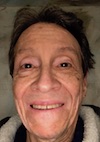 Sheltering in Place
Sheltering in Place
My thanks to those who have called, emailed and texted to see if we’re all okay here. The short answer: So far, so good.
From the outset, every credible advisory has suggested that my cohort faces a particularly high risk of contagion from COVID-19. So, even before it became a requirement, I began self-isolating here in our Staten Island home, having decided that, though I don’t look or feel my age, the coronavirus causing this pandemic will likely not respect that perception.
I don’t do much traveling nowadays, so I wasn’t engaging in social interaction in crowded situations. Nonetheless, on March 10, as a precaution, I decided to cancel a next-day dentist’s appointment in Manhattan, not just out of concern for the risk involved in the inevitable close physical contact that scheduled cleaning would have required but because it would have necessitated travel by bus, ferry, and subway going in and the reverse on the return trip. (I promised my hygienist that, in addition to brushing, I would rinse with mouthwash daily and even floss now and then to compensate.) I do not plan to venture into Manhattan again until life returns to normal.
•
Which will be when? Who knows? And will look like what, exactly? Dystopian? Post-apocalyptic? Millennarian?
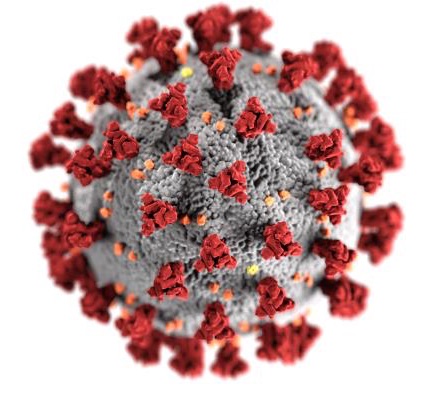
Coronavirus (COVID-19), as depicted by the Center for Disease Control (CDC), 2020
Even the best-case scenario, in which COVID-19 runs its course here in the States within the next three months, guarantees a dramatically reconfigured world upon entry into what will become the new normal. The fields in which I have worked my entire adult life and from which nowadays I derive minimal but still necessary income — art, photography, post-secondary education — will have undergone devastation and drastic reconfiguration. On top of individual deaths, countless organizations and institutions will have folded their tents; indeed, the entire heretofore ostensibly robust infrastructure that supports these aspects of culture may have collapsed. As a result, many cultural workers, potentially including me and my family, will likely find ourselves broke and possibly bankrupt, with no useful in-demand transferable skills and thus no prospects for employment. And if the predictions for a second wave in the fall come true, it will get much worse.
A strange time to find oneself alive and (presumably) well, I must say.
Over the past year — indeed, ever since the 2016 election — I have become progressively demoralized. Truly pessimistic, for the first time, about both the immediate future and the long-term prospects. As a rule, I consider myself a realist — neither an optimist nor a pessimist, albeit generally hopeful, in the sense that Václav Havel defined it in his book Disturbing the Peace:
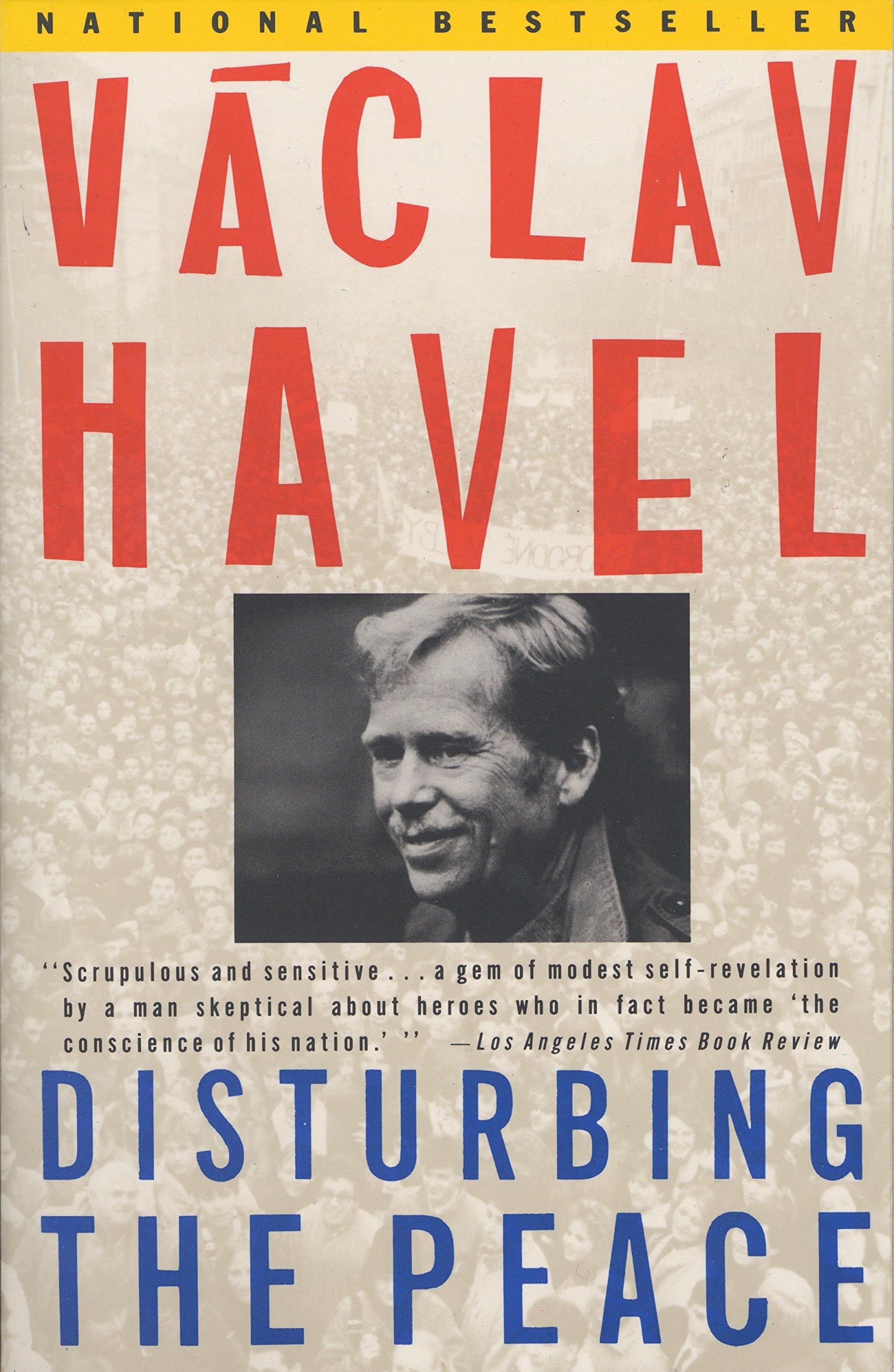
Vaclav Havel, Disturbing the Peace (1991), cover
Either we have hope within us or we don’t; it is a dimension of the soul, and it’s not essentially dependent on some particular observation of the world or estimate of the situation. Hope is not prognostication. It is an orientation of the spirit, an orientation of the heart. …
Hope, in this deep and powerful sense, is not the same as joy that things are going well, or willingness to invest in enterprises that are obviously headed for early success, but rather, an ability to work for something because it is good, not just because it stands a chance to succeed. …
Hope is definitely not the same thing as optimism. It is not the conviction that something will turn out well, but the certainty that something makes sense, regardless of how it turns out. … It is also this hope, above all, which gives us the strength to live and continually try new things, even in conditions that seem as hopeless as ours do, here and now.
I believe that. Yet I find it hard to maintain the energy this attitude requires in the face of what appear as existential threats on all levels: personal (this virus as a possibly fatal health hazard, not to mention the financial havoc it may wreak on me and mine); societal (the damage this virus may cause in this country on so many levels, compounded by the collapse of democracy under the Trumpublicans); and global (the imminent tipping point of catastrophic climate change, icing the cake).
I don’t recall feeling this sense of paralysis in the face of looming apocalypse — an awareness that it, this, all of this, the world as I know it, could actually end — since the Cuban missile crisis of 1962. And that confrontation had a short life, with hardly anyone on either side wanting it to end in actual war. In contrast, this conglomeration of disasters has built up incrementally and moves forward cumulatively at a slower speed — just fast enough that you can imagine the inevitable end and know that you will likely witness it first-hand, with that mental condition of suspended time that someone who has experienced a car wreck may remember.
•
Nevertheless, like Samuel Beckett’s Molloy, “Where I am, I don’t know, I’ll never know, in the silence you don’t know, you must go on, I can’t go on, I’ll go on.”
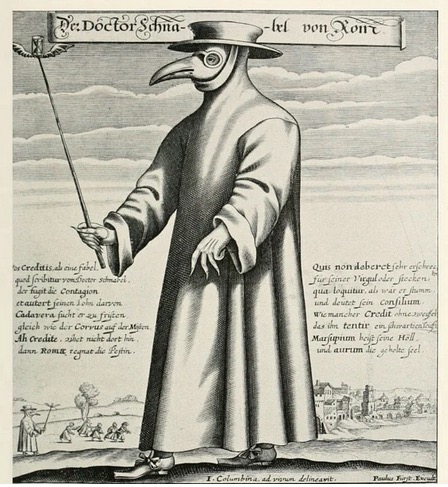
Physician’s Uniform, Black Death, ca. 1350
Sure, it’s possible that we’re all gonna die. But look at the bright side: The Black Death’s decimation of the Europeans made the Renaissance possible, and cutting a vast swathe through the international population today will surely reduce humanity’s carbon footprint considerably, perhaps buying the survivors a little time in which to address global warming. Not to mention opening up unimaginable opportunities.
Moreover, the evangelical Christian right’s devotion to Trump and Trumpism, its preference for unhinged conspiratorial gossip over investigative journalism and fact, its endorsement of superstition over science, its hostility to any kind of social intervention from “big government” and/or the “deep state,” and its bring-on-the-End-Times-we’re-ready-for-the-Rapture hysteria all virtually guarantee that the true believers who constitute the base of the Trump cult will prove the hardest hit by this pandemic. While I don’t wish disease and death on anyone, the inevitable forthcoming statistical decimation of this malignant cohort can only contribute positively to a possible recovery of something resembling democracy in the aftermath of the plague.
•
So, if I, and you, want to wallow in depression and negativity, we can click here to listen to The Fugs sing “Nothing.”
We can also enter into the endless winding corridors of Bob Dylan’s new epic, “Murder Most Foul,” whose unexpected release at this exact moment — not accidental or even coincidental, but precisely timed — surely implies that everything in this country started inexorably turning to shit with the 1963 assassination of JFK, which has somehow brought us to this point. A belief that, as it happens, I share.
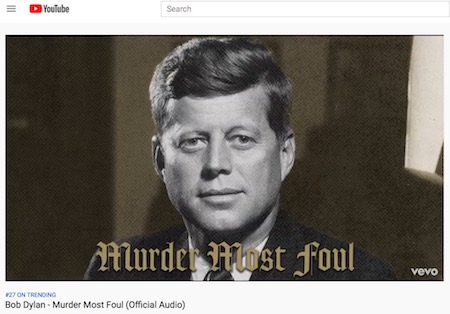
Bob Dylan, “Murder Most Foul” video, YouTube (2020), screenshot
•
Or we can lift our spirits by:
(a) listening to the Fake Beatles sing “I Gotta Wash My Hands!”
(b) watching and listening to Chris Mann’s “My Corona”;
(c) watching and listening to Roy Zimmerman’s “The Liar Tweets Tonight”;
(d) watching and listening to the Muppets perform Queen’s “Bohemian Rhapsody” (while social-distancing);
(e) joining Eric Idle in the finale of Life of Brian, “Always Look On The Bright Side of Life.”
We can also chill to the free download (legit) of Is That So?, a fine new world-music album by John McLaughlin, Shankar Mahadevan, and Zakir Hussain.
The choice is yours, and mine. Among my mottoes I include “Nihilism: There’s no future in it.” I find I can only mope and grump for so long before it gets boring. So I’ve laid in a supply of unpopped kernels for my hot-air popcorn machine. Let’s watch the show.
•
poetic license / poetic justice
I have just published a new book, which falls somewhere between my creative writing and my work as a critic and historian. A one-off project, in that sense — the result of trying to find a voice to echo/mimic/parallel/play off of the voice of the late David Antin, a founder of the school called “language poetry.”

Allan Douglass Coleman, poetic license / poetic justice (2020), cover
Titled poetic license / poetic justice: a footnote to “the london march” by david antin, this prose poem of mine has as its jumping-off point a poem by Antin — composed in 1968, first published in 1972, and republished in 2001 — in a section of which my family plays a role. That passage recounts, fragmentarily and of course from Antin’s perspective, a failed wildcat strike in which he participated at the small publishing house where he worked in the late 1950s, a business owned and operated by my parents.
Here are the opening paragraphs of my response to Antin’s piece:
my father makes a personal appearance in a somewhat famous poem by david antin or to put a finer point on it david antin sketched out on paper & then talked & taperecorded & transcribed & published a section about my father in one of his “talking” poems
no this isnt some nabokovian pale fire moment nor an equivalent to art critic douglas crimp deciding & declaring that a portion of a certain piece of postmodernist architecture was about him its actually my father clearly identifiable though he isnt named & this section of the antin poem describes an episode i lived through in my early teens so i can verify it personally my father vouches for it too in fact i know it practically by heart because my father no slouch himself as a storyteller has taken great pleasure in recounting it over the years but you could also check it out by searching old federal & state tax rolls & new york city department of labor employment records & the files of new york local 65 & other available archives & david would probably confirm the name of his subject to you as he did to me when i met him in san diego in 1974 shortly after first reading this piece of his
the poem is called “the london march: an improvisation for 2 voices” & has become a famous one at least in certain admittedly small circles that value a specific narrow approach to experimental poetry according to marjorie perloff who should know it is certifiably bluechip avantgarde & has attained the status of a classic influencing the language poetry movement perloff says so i suppose that to whatever extent artists confer immortality on their subjects a dicey notion at best very presumptuous to say the least david thus immortalized my father though i think pop has other & better claims to fame in any case my interest here has to do with exploring the relationship between poetic license & poetic justice
As I put it toward the end of this piece,
i came across the reissue of davids “talking” at strand books in manhattan in november 2006 & understood that for better or worse & not by our own choosing my family history had entered into the dna of experimental poetry in the second half of the twentieth century & decided that we that is to say us my family who also lived through that strike to be specific earl & fran & me & my younger brother dennis that our dna to whatever extent i embody & represent it should have some voice in the process
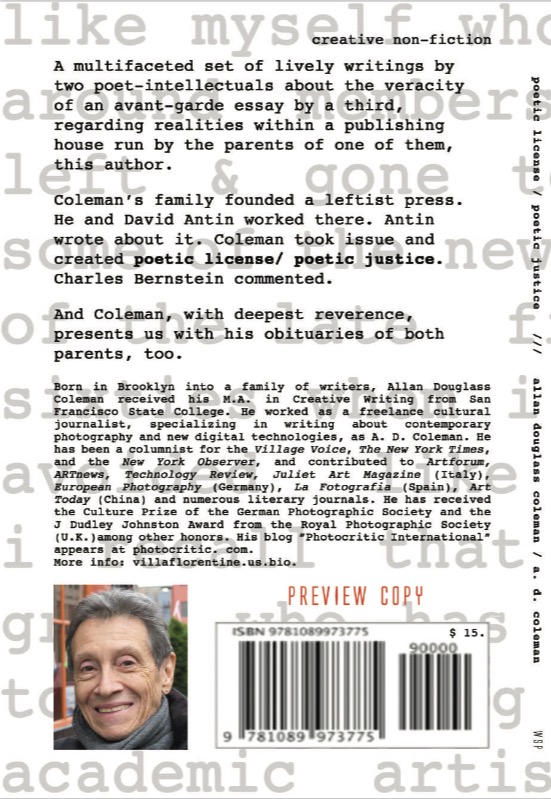
Allan Douglass Coleman, poetic license / poetic justice (2020), back cover
Though it explicates aspects of my personal history that some may find illuminating in regard to my professional activities, this piece doesn’t really fall into what I consider the territory of my practice as a critic and historian. So I published it under my full name, Allan Douglass Coleman, which I use for my creative writing. Fundamentally, it has no direct connection to photography. With that said, the sharp-eyed reader who knows the medium’s post-World War II history may notice therein commentary on a certain post-secondary southern-Californian photo program and several of its graduates, at least one of whom went on to have a distinctive presence in the field.
As added features, the book includes an email exchange with Charles Bernstein, arguably the foremost Antin scholar, and the obituaries of both my parents, Earl Coleman and Frances Coleman.
Anyhow, this book — a chapbook, in the parlance of what some call the “po biz” — appears under the imprint of Washington Street Press, in which new line it’s the first title. My thanks to photographer / writer / multimedia artist Barbara Rosenthal for selecting it for that purpose. You can order it from Amazon here. Donate $50 via the PayPal button in the right-hand column and I’ll send you a signed copy.
•
I Had No Idea Dep’t.
“Glass is a liquid in suspended animation, a liquid whose molecules curiously cannot flow. Ideal glass, if it exists, would tell us why.” — Natalie Wolchover, “Ideal Glass Would Explain Why Glass Exists at All,” Quanta magazine, March 11, 2020.
Now there’s an image to ponder next time you pick up your camera, or any other lens instrument.
•
This post sponsored by a donation from photographer Harry Wilks.
•
Special offer: If you want me to either continue pursuing a particular subject or give you a break and (for one post) write on a topic — my choice — other than the current main story, make a donation of $50 via the PayPal widget below, indicating your preference in a note accompanying your donation. I’ll credit you as that new post’s sponsor, and link to a website of your choosing.
Spring Fever/Cabin Fever: Bits & Pieces (2020)
My thanks to those who have called, emailed and texted to see if we’re all okay here. The short answer: So far, so good.
From the outset, every credible advisory has suggested that my cohort faces a particularly high risk of contagion from COVID-19. So, even before it became a requirement, I began self-isolating here in our Staten Island home, having decided that, though I don’t look or feel my age, the coronavirus causing this pandemic will likely not respect that perception.
I don’t do much traveling nowadays, so I wasn’t engaging in social interaction in crowded situations. Nonetheless, on March 10, as a precaution, I decided to cancel a next-day dentist’s appointment in Manhattan, not just out of concern for the risk involved in the inevitable close physical contact that scheduled cleaning would have required but because it would have necessitated travel by bus, ferry, and subway going in and the reverse on the return trip. (I promised my hygienist that, in addition to brushing, I would rinse with mouthwash daily and even floss now and then to compensate.) I do not plan to venture into Manhattan again until life returns to normal.
•
Which will be when? Who knows? And will look like what, exactly? Dystopian? Post-apocalyptic? Millennarian?
Coronavirus (COVID-19), as depicted by the Center for Disease Control (CDC), 2020
Even the best-case scenario, in which COVID-19 runs its course here in the States within the next three months, guarantees a dramatically reconfigured world upon entry into what will become the new normal. The fields in which I have worked my entire adult life and from which nowadays I derive minimal but still necessary income — art, photography, post-secondary education — will have undergone devastation and drastic reconfiguration. On top of individual deaths, countless organizations and institutions will have folded their tents; indeed, the entire heretofore ostensibly robust infrastructure that supports these aspects of culture may have collapsed. As a result, many cultural workers, potentially including me and my family, will likely find ourselves broke and possibly bankrupt, with no useful in-demand transferable skills and thus no prospects for employment. And if the predictions for a second wave in the fall come true, it will get much worse.
A strange time to find oneself alive and (presumably) well, I must say.
Over the past year — indeed, ever since the 2016 election — I have become progressively demoralized. Truly pessimistic, for the first time, about both the immediate future and the long-term prospects. As a rule, I consider myself a realist — neither an optimist nor a pessimist, albeit generally hopeful, in the sense that Václav Havel defined it in his book Disturbing the Peace:
Vaclav Havel, Disturbing the Peace (1991), cover
Either we have hope within us or we don’t; it is a dimension of the soul, and it’s not essentially dependent on some particular observation of the world or estimate of the situation. Hope is not prognostication. It is an orientation of the spirit, an orientation of the heart. …
Hope, in this deep and powerful sense, is not the same as joy that things are going well, or willingness to invest in enterprises that are obviously headed for early success, but rather, an ability to work for something because it is good, not just because it stands a chance to succeed. …
Hope is definitely not the same thing as optimism. It is not the conviction that something will turn out well, but the certainty that something makes sense, regardless of how it turns out. … It is also this hope, above all, which gives us the strength to live and continually try new things, even in conditions that seem as hopeless as ours do, here and now.
I believe that. Yet I find it hard to maintain the energy this attitude requires in the face of what appear as existential threats on all levels: personal (this virus as a possibly fatal health hazard, not to mention the financial havoc it may wreak on me and mine); societal (the damage this virus may cause in this country on so many levels, compounded by the collapse of democracy under the Trumpublicans); and global (the imminent tipping point of catastrophic climate change, icing the cake).
I don’t recall feeling this sense of paralysis in the face of looming apocalypse — an awareness that it, this, all of this, the world as I know it, could actually end — since the Cuban missile crisis of 1962. And that confrontation had a short life, with hardly anyone on either side wanting it to end in actual war. In contrast, this conglomeration of disasters has built up incrementally and moves forward cumulatively at a slower speed — just fast enough that you can imagine the inevitable end and know that you will likely witness it first-hand, with that mental condition of suspended time that someone who has experienced a car wreck may remember.
•
Nevertheless, like Samuel Beckett’s Molloy, “Where I am, I don’t know, I’
Physician’s Uniform, Black Death, ca. 1350
Sure, it’s possible that we’re all gonna die. But look at the bright side: The Black Death’s decimation of the Europeans made the Renaissance possible, and cutting a vast swathe through the international population today will surely reduce humanity’s carbon footprint considerably, perhaps buying the survivors a little time in which to address global warming. Not to mention opening up unimaginable opportunities.
Moreover, the evangelical Christian right’s devotion to Trump and Trumpism, its preference for unhinged conspiratorial gossip over investigative journalism and fact, its endorsement of superstition over science, its hostility to any kind of social intervention from “big government” and/or the “deep state,” and its bring-on-the-End-Times-we’re-ready-for-the-Rapture hysteria all virtually guarantee that the true believers who constitute the base of the Trump cult will prove the hardest hit by this pandemic. While I don’t wish disease and death on anyone, the inevitable forthcoming statistical decimation of this malignant cohort can only contribute positively to a possible recovery of something resembling democracy in the aftermath of the plague.
•
So, if I, and you, want to wallow in depression and negativity, we can click here to listen to The Fugs sing “Nothing.”
We can also enter into the endless winding corridors of Bob Dylan’s new epic, “Murder Most Foul,” whose unexpected release at this exact moment — not accidental or even coincidental, but precisely timed — surely implies that everything in this country started inexorably turning to shit with the 1963 assassination of JFK, which has somehow brought us to this point. A belief that, as it happens, I share.
Bob Dylan, “Murder Most Foul” video, YouTube (2020), screenshot
•
Or we can lift our spirits by:
(a) listening to the Fake Beatles sing “I Gotta Wash My Hands!”
(b) watching and listening to Chris Mann’s “My Corona”;
(c) watching and listening to Roy Zimmerman’s “The Liar Tweets Tonight”;
(d) watching and listening to the Muppets perform Queen’s “Bohemian Rhapsody” (while social-distancing);
(e) joining Eric Idle in the finale of Life of Brian, “Always Look On The Bright Side of Life.”
We can also chill to the free download (legit) of Is That So?, a fine new world-music album by John McLaughlin, Shankar Mahadevan, and Zakir Hussain.
The choice is yours, and mine. Among my mottoes I include “Nihilism: There’s no future in it.” I find I can only mope and grump for so long before it gets boring. So I’ve laid in a supply of unpopped kernels for my hot-air popcorn machine. Let’s watch the show.
•
poetic license / poetic justice
I have just published a new book, which falls somewhere between my creative writing and my work as a critic and historian. A one-off project, in that sense — the result of trying to find a voice to echo/mimic/parallel/play off of the voice of the late David Antin, a founder of the school called “language poetry.”
Allan Douglass Coleman, poetic license / poetic justice (2020), cover
Titled poetic license / poetic justice: a footnote to “the london march” by david antin, this prose poem of mine has as its jumping-off point a poem by Antin — composed in 1968, first published in 1972, and republished in 2001 — in a section of which my family plays a role. That passage recounts, fragmentarily and of course from Antin’s perspective, a failed wildcat strike in which he participated at the small publishing house where he worked in the late 1950s, a business owned and operated by my parents.
Here are the opening paragraphs of my response to Antin’s piece:
my father makes a personal appearance in a somewhat famous poem by david antin or to put a finer point on it david antin sketched out on paper & then talked & taperecorded & transcribed & published a section about my father in one of his “talking” poems
no this isnt some nabokovian pale fire moment nor an equivalent to art critic douglas crimp deciding & declaring that a portion of a certain piece of postmodernist architecture was about him its actually my father clearly identifiable though he isnt named & this section of the antin poem describes an episode i lived through in my early teens so i can verify it personally my father vouches for it too in fact i know it practically by heart because my father no slouch himself as a storyteller has taken great pleasure in recounting it over the years but you could also check it out by searching old federal & state tax rolls & new york city department of labor employment records & the files of new york local 65 & other available archives & david would probably confirm the name of his subject to you as he did to me when i met him in san diego in 1974 shortly after first reading this piece of his
the poem is called “the london march: an improvisation for 2 voices” & has become a famous one at least in certain admittedly small circles that value a specific narrow approach to experimental poetry according to marjorie perloff who should know it is certifiably bluechip avantgarde & has attained the status of a classic influencing the language poetry movement perloff says so i suppose that to whatever extent artists confer immortality on their subjects a dicey notion at best very presumptuous to say the least david thus immortalized my father though i think pop has other & better claims to fame in any case my interest here has to do with exploring the relationship between poetic license & poetic justice
As I put it toward the end of this piece,
i came across the reissue of davids “talking” at strand books in manhattan in november 2006 & understood that for better or worse & not by our own choosing my family history had entered into the dna of experimental poetry in the second half of the twentieth century & decided that we that is to say us my family who also lived through that strike to be specific earl & fran & me & my younger brother dennis that our dna to whatever extent i embody & represent it should have some voice in the process
Allan Douglass Coleman, poetic license / poetic justice (2020), back cover
Though it explicates aspects of my personal history that some may find illuminating in regard to my professional activities, this piece doesn’t really fall into what I consider the territory of my practice as a critic and historian. So I published it under my full name, Allan Douglass Coleman, which I use for my creative writing. Fundamentally, it has no direct connection to photography. With that said, the sharp-eyed reader who knows the medium’s post-World War II history may notice therein commentary on a certain post-secondary southern-Californian photo program and several of its graduates, at least one of whom went on to have a distinctive presence in the field.
As added features, the book includes an email exchange with Charles Bernstein, arguably the foremost Antin scholar, and the obituaries of both my parents, Earl Coleman and Frances Coleman.
Anyhow, this book — a chapbook, in the parlance of what some call the “po biz” — appears under the imprint of Washington Street Press, in which new line it’s the first title. My thanks to photographer / writer / multimedia artist Barbara Rosenthal for selecting it for that purpose. You can order it from Amazon here. Donate $50 via the PayPal button in the right-hand column and I’ll send you a signed copy.
•
I Had No Idea Dep’t.
“Glass is a liquid in suspended animation, a liquid whose molecules curiously cannot flow. Ideal glass, if it exists, would tell us why.” — Natalie Wolchover, “Ideal Glass Would Explain Why Glass Exists at All,” Quanta magazine, March 11, 2020.
Now there’s an image to ponder next time you pick up your camera, or any other lens instrument.
•
This post sponsored by a donation from photographer Harry Wilks.
•
Special offer: If you want me to either continue pursuing a particular subject or give you a break and (for one post) write on a topic — my choice — other than the current main story, make a donation of $50 via the PayPal widget below, indicating your preference in a note accompanying your donation. I’ll credit you as that new post’s sponsor, and link to a website of your choosing.